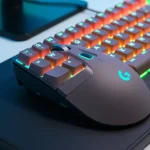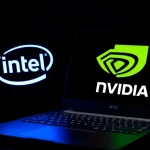Intel Arc graphics struggle for clarity after Nvidia’s $5B RTX deal

In a surprising twist in the tech industry, Intel and Nvidia have announced a groundbreaking partnership that could redefine the landscape of graphics processing. With Nvidia investing a staggering $5 billion into Intel, the future of their collaboration is both promising and uncertain, particularly concerning Intel's own graphics line, Arc. As we dive deeper into this partnership, it becomes crucial to understand the implications for Intel's Arc project and how it fits into the broader market.
the promising yet brief history of Intel Arc
Intel Arc, despite being relatively new in the graphics card arena, has already shown signs of potential. The journey began with the cancellation of Intel's early “Larrabee” architecture, which was left behind as the demand for GPUs surged, especially with the rise of Bitcoin mining and Artificial Intelligence applications. Intel recognized the urgent need to pivot and initiated the development of the Arc brand alongside its Xe graphics architecture.
The first Arc graphics cards made their debut in October 2022, garnering attention for their competitive pricing and performance. While initial releases were plagued by software bugs, Intel quickly addressed these issues, leading to improved performance with subsequent iterations. By the time the Arc B580 was released in late 2024, it was heralded as “the first worthy budget GPU of the decade,” providing a notable uplift in gaming experiences for budget-conscious consumers.
Moreover, the Xe architecture is not just confined to standalone graphics cards; it also enhances integrated graphics in Intel’s CPUs, bringing significant boosts in laptop gaming performance. This dual application highlights the versatility and potential of Intel's graphics technology.
challenges faced by Intel Arc
However, entering the competitive GPU market, particularly against established giants like Nvidia and AMD, is not without its hurdles. One of the primary challenges facing Intel Arc is the inherent disparity in GPU hardware capabilities. Currently, Intel's discrete Arc GPUs are larger and more expensive to manufacture than their competitors. For instance, the die size of the Arc B580 measures a substantial 292 mm, while Nvidia's RTX 4060 and RTX 5060 sit at approximately 150 mm and 181 mm, respectively.
- Arc B580 die size: 292 mm
- Nvidia RTX 4060 die size: 150 mm
- Nvidia RTX 5060 die size: 181 mm
This discrepancy in size not only translates to higher production costs but also affects market competitiveness. Furthermore, Intel’s Tom Peterson has candidly referred to the Arc B580 as a “loss leader,” indicating that the company is willing to incur initial losses to establish a foothold and nurture a stronger graphics lineup in the future. However, this strategy is now called into question with Nvidia's substantial investment in Intel.
the implications of Intel's partnership with Nvidia
The recent partnership with Nvidia is poised to reshape Intel’s trajectory in the GPU market. While Intel has assured that no immediate changes to its roadmap are planned, the significance of Nvidia's investment cannot be understated. The collaboration aims to integrate Nvidia’s RTX graphics technology into Intel’s x86 processors for both consumer and data center applications. This marks a pivotal shift in Intel’s approach, bridging gaps in their GPU technology.
Given that Nvidia has historically dominated the high-performance graphics market, this partnership could potentially enable Intel to leverage Nvidia's expertise and technologies to enhance its own offerings. The collaboration could lead to:
- Improved integration of RTX graphics in consumer CPUs.
- Enhanced data center solutions combining Intel's CPUs with Nvidia's GPUs.
- Joint innovation in AI and machine learning applications.
However, the question remains: does this investment diminish the need for Intel to independently develop and promote its Arc graphics line? If Nvidia’s technology becomes the focus, will there still be a market for Arc? Intel has indicated that it will continue to invest in its GPU developments, but this strategy could be influenced by the dynamics of the Nvidia partnership.
strategic considerations for Intel's Arc project
From a strategic viewpoint, maintaining the Arc brand could provide a safety net for Intel. If the partnership with Nvidia were to falter, having Arc and Xe technologies available would safeguard against potential vulnerabilities in Intel’s graphics strategy. This is particularly crucial as the market landscape is ever-changing, and relying solely on a partner carries inherent risks.
Moreover, the current GPU landscape is marked by fierce competition, especially in entry-level markets where both Arc and Xe have fostered innovation. The future of Intel’s graphics strategy could hinge on a few critical factors:
- The ability to maintain competitive pricing in the budget GPU segment.
- Continued innovation to address any hardware performance gaps compared to Nvidia and AMD.
- Adaptation to market demands and shifts in consumer preferences.
While Intel is optimistic about its partnership with Nvidia, it must balance this collaboration with its internal graphics ambitions. The evolution of consumer demand for GPUs and the competitive landscape will dictate how effectively Intel can navigate these waters in the coming years.
the uncertain future of Intel Arc amidst industry shifts
As we look ahead, the future of Intel's Arc project remains a blend of certainty and ambiguity. The partnership with Nvidia provides a unique opportunity for growth and innovation, yet it also introduces a layer of uncertainty regarding Intel's standalone graphics efforts. Analysts predict that we may not see significant announcements regarding Intel's GPU roadmaps for another two to three years, as both companies work to solidify their collaborative frameworks.
Despite these uncertainties, the Arc brand has already begun to carve out a niche in the budget graphics market. With the B580 hailed as the best budget GPU of the decade, there is evidence that Intel can compete effectively at lower price points. However, the longevity of Arc will depend on:
- The company’s ability to continuously enhance its graphics technology.
- Market response to future products developed under the Nvidia partnership.
- Intel’s overall financial health and strategic direction moving forward.
The stakes are high, and the landscape is shifting rapidly. Intel’s ability to adapt and innovate will ultimately determine whether Arc can thrive alongside Nvidia’s influence or if it will be overshadowed in the ever-evolving graphics market.




Leave a Reply